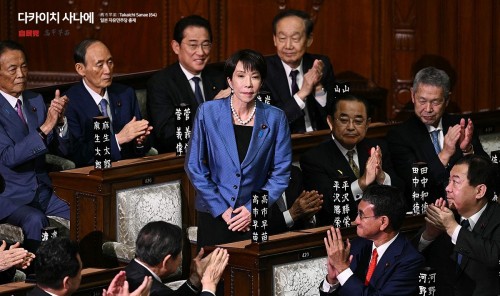 |
| Sanae Takaichi, leader of Japan’s ruling Liberal Democratic Party, is elected as the country’s first female prime minister during a parliamentary vote in Tokyo on October 21. / Source: AFP・Yonhap News |
Japan entered a new political era on October 21 as Sanae Takaichi, leader of the ruling Liberal Democratic Party (LDP), was formally elected and sworn in as the nation’s first female prime minister.
The 64-year-old Takaichi secured overwhelming support in the parliamentary vote, becoming Japan’s 104th prime minister. Known as the “female Abe,” she has pledged to carry on the late Shinzo Abe’s economic and conservative agenda, consolidating her dominance within the ruling party. Her inauguration also marks the end of the LDP’s 26-year coalition with Komeito and the beginning of a new conservative alliance government with the Japan Innovation Party.
Takaichi’s core economic platform centers on reviving “Abenomics” through aggressive monetary easing and expansive fiscal spending. Her policies emphasize growth, job creation, technological innovation, and large-scale infrastructure investment.
Markets responded positively to her victory. The Nikkei 225 index surged more than 1.9% after her election, reflecting investor optimism over political stability and policy continuity.
In forming her cabinet, Takaichi balanced conservative veterans with younger and female politicians, promoting what she calls “active leadership across all generations.” However, coordination challenges between the LDP and the Japan Innovation Party could become key political tests, given their differing policy priorities and ideological stances.
Politically, her rise signifies the collapse of the long-standing LDP–Komeito partnership and the beginning of a broader realignment within Japan’s conservative camp. By aligning with the Japan Innovation Party, the LDP is seeking to redefine its policy direction and reassert control over Japan’s right-of-center political landscape.
As Japan’s first female leader, Takaichi’s ascent carries immense symbolic weight. She has vowed to promote women’s political participation and social diversity, though her deeply conservative ideology and close association with Abe’s legacy could deepen existing political and social divides.
Takaichi’s strong ties to senior party figures and her close relationship with the late Abe helped solidify her power base. Yet, she still faces scrutiny over past controversies, including allegations of political interference in broadcasting.
Economically, she plans to tackle Japan’s structural challenges — from rapid aging and population decline to supply-chain vulnerabilities — by focusing on growth-driven reforms, sustainable welfare, and investment in digital and green industries.
Sanae Takaichi’s premiership marks a historic turning point for Japan. Her leadership will test whether Japan’s conservative forces can reinvent themselves while navigating domestic reform and shifting global dynamics. The world now watches to see what kind of leadership Japan’s first female prime minister will bring.
Most Read
-
1
-
2
-
3
-
4
-
5
-
6
-
7





















